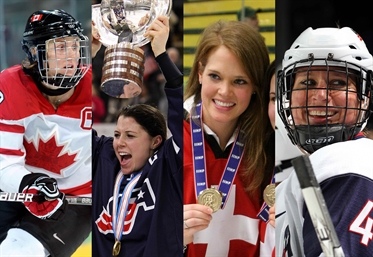Big year for women's hockey
Big year for women's hockey
Stories aplenty to follow in 2015-16

 The women's hockey season will feature many familiar faces along with a few new ones. From left: Hayley Wickenheiser, Jincy Dunne, Florence Schelling, and Angela Ruggiero.
The women's hockey season will feature many familiar faces along with a few new ones. From left: Hayley Wickenheiser, Jincy Dunne, Florence Schelling, and Angela Ruggiero.
But between now and then there is much to follow in the women’s game, both in North America and Europe, within the IIHF and outside it. Herewith are the top stories worth keeping an eye on.
1. Will the NWHL get going as planned?
Founded by Dani Rylan earlier this year, the NWHL bills itself as the first truly professional women’s league, one that will pay its players a contracted salary. But with the season opener less than a month away, many questions remain unanswered. Sponsorship money is scarce, rosters are not filled, and financing uncertain. If all goes well, the four teams will be the Boston Pride, Buffalo Beauts, Connecticut Whale, and New York Riveters, and they’ll play for the Isobel Cup (as in Lady Isobel, wife of Lord Stanley of Preston).
2. Where is Amanda Kessel?
Kessel was hands-down the best female player in the world during the period 2012-14. She had a dominating year in ’12-’13, winning the Patty Kazmaier Award with the Minnesota Golden Gophers and guiding the USA to a gold medal at the Women’s Worlds. But she suffered a concussion in the leadup to the Sochi Olympics and by the fall was forced to withdraw from school for the year. She remains inactive and virtually invisible, a shocking downward spiral of events for the once-dominant forward.
3. Where will Shannon Miller wind up?
Coach Miller was let go by the University of Minnesota-Duluth in what it claimed was a financial decision, but it’s hard to fathom her extraordinary success at UMD having so little currency to the college. Nonetheless, Miller hasn’t yet signed on anywhere and for now appears to be in limbo, but one can be sure she’ll be back in the women’s game somewhere, somehow. Whoever gets her will be the better for it.
4. Can Jincy thrive under Jenny?
After having an extraordinary U18 career, capped by scoring the game-winning goal in overtime at the gold-medal game in the 2015 WW18 in Buffalo, defenceman Jincy Dunne embarks on a university career with Ohio State. Her older sister, Jessica, is a member of the women’s Buckeyes, and the incoming coach in none other than Jenny Potter, a long time member of the USA’s senior team. Jincy is poised to become a key player herself at the senior level, but she’ll need four years of development first.
5. Who will be inducted into the IIHF Hall of Fame?
Now that the Hockey Hall of Fame has announced the forthcoming induction of Angela Ruggiero into its class on 2015 for this November, all eyes look to the IIHF’s Hall of Fame selection process. The committee will meet at the end of November to consider all candidates, and there is no shortage of women's hockey legends, starting with Ruggiero and her old coach, Ben Smith. Canadians are also an integral part of the possibilities, notably Nancy Drolet, Therese Brisson, Vicky Sunohara, and Cassie Campbell.
6. Who will automatically qualify for PyeongChang?
The 2016 Women’s Worlds is a key event for the 2018 Olympics. The top five teams in that event automatically qualify for the games in Korea, as well as the host nation. Given that Canada and the United States are a essentially locks to qualify, that leaves three spots for five teams. Finland has to be a good bet as well, but Sweden will get stiff competition from Russia, the Swiss, and perhaps even the Czechs. Those teams that don’t qualify at the WW will have to try again through Olympic qualification tournaments scheduled for the 2016-17 season.
7. Can Hayley still be Hayley?
The name Hayley Wickenheiser is legendary in women’s hockey. She began her career at the 1994 Women’s Worlds and has played in all five Olympics, and she is the all-time leader in virtually every offensive category. But she missed the 2015 WW with a serious foot injury and is only now getting back on ice with the Hockey Canada program. She’ll also play the upcoming season with the Calgary Inferno in the CWHL, but the once dominant forward just turned 37. She wants to play in PyeongChang, but will she still have the ability?
8. Can Switzerland rebound?
The Swiss, led by goalie Florence Schelling, won an historic bronze medal at the Sochi Olympics but lost 3-0 to Finland in the quarter-finals of the 2015 WW and finished a disappointing sixth. Schelling is now playing in Linkoping, Sweden, for Kim Martin’s old team, and as she pads the record books (most games played, most minutes played), the Swiss have to find ways to get more scoring into the lineup. Failure to do so might cost the team a trip to Korea in 2018.
9. Will the Czechs stay up with youth?
Although the Czechs have played in women’s events since 1999, they have qualified only twice for the top level: the first time in 2013, after which they were summarily relegated, and this coming season, after winning Division I-A in 2015. The team is stacked with youth. Some 14 of the 22 players that helped win the promotion for 2016 are still teenagers, but can they compete at the top level or does relegation await again? This could be a team that causes trouble for the usual top nations.
10. What does Beijing 2022 mean for the women’s game?
When Beijing was recently awarded the 2022 Olympic Winter Games, Chinese officials immediately promised to build hundreds of new hockey rinks and develop youth programs to make the team would be competitive at a world-class level in seven years. Heady promises. This is a task mush better suited for the women’s game than the men, and given the Chinese success in the first two decades of women’s hockey at the IIHF, it might be one that can be fulfilled as promised. If so, they have to start developing new programs and ways to get girls playing sooner rather than later.
Back to Overview

















































